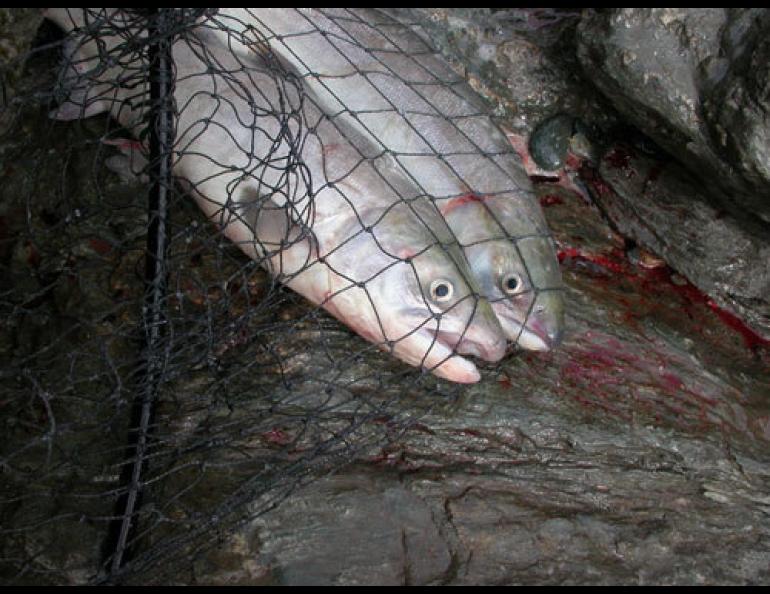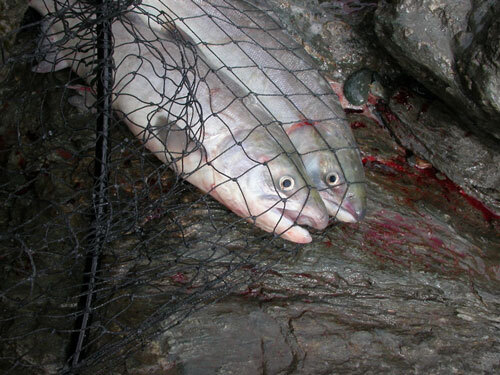
Parts of Alaska fish we don’t usually eat are high in useful oils. Researchers think there’s a potential industry of extracting those oils from the byproducts of fish processors. Photo by Ned Rozell, Geophysical Institute.
Alaska fare from a northern science conference
Some notes from the pad, scribbled during the 2008 Arctic Science Conference held in Fairbanks, September 15 - 17:
- In Eagle, Alaska, the Yukon River has broken up in April rather than May only 12 times in about one century of records. Ten of those early breakups happened between 1989 and 2008, according to Eagle resident and historian John Borg.
- Willows may be responding to crowding pressure from the exotic white sweet clover by producing more tannins, which make willow less tasty to moose. James Sowerwine of the University of Alaska Anchorage also thinks white sweet clover may already be stunting willow growth on the Nenana River.
- Ted Wu of the USDA Agricultural Research Service at UAF has been gathering up fish guts and heads by the bucketful at Kodiak fish processors and bringing them back to Fairbanks. In the lab, he and his co-workers have ground up the heads and guts of salmon, and the bones, heads, skin, and guts of pollock. They have found that those byproducts of Alaska fisheries are rich in oils that are great sources of polyunsaturated fatty acids and fat-soluble vitamins. The oils, not widely exploited at the moment, could be used for human consumption (in pill form), animal feed, or possibly for biodiesel fuel.
- According to precise dating of bones reported by Dale Guthrie, elk lived in Fairbanks about 260 years ago, and moose have roamed Alaska as long as humans have, about 12,000 years.
- If climate warming patterns continue, black and white spruce trees will grow better along the western half of the Kuskokwim River than they will on the eastern half of the Kuskokwim River, which has a dryer interior climate, according to Stephen Winslow of UAF. Spruce trees seem to do better in cooler, wetter locations.
- Tlingit and Haida people of southeast Alaska had gardens more than 200 years ago, and potatoes were one of their most important crops. Old strains of potatoes growing in Juneau and the village of Kasaan, near Ketchikan, are related to potatoes farther south. “These were not brought over by Russians or Europeans,” said Elizabeth Kunibe of the University of Alaska Southeast, who looked at a DNA analysis of the potatoes. “They had to come up from Chile or Mexico.”
The remaining nuggets are from a talk “What is the future role of wild game in Alaska food systems?” by Tom Paragi of the Alaska Department of Fish and Game:
- Alaska agriculture provides less than 5 percent of the state’s food needs. We import the rest.
- The average rural Alaskan harvests about 375 pounds of wild food per year. The average urban Alaskan harvests about 23 pounds of wild food per year.
- Three game management units surrounding Fairbanks and Delta Junction account for one-third of the moose taken in Alaska.
- Alaskans harvested about 6,900 moose per year from 2001 to 2005. About one percent of the Alaska population got a moose during that time. During the same period, Alaskans harvested about 27,679 caribou per year and 18,079 deer.
- Eighty-five percent of the red meat Alaskans eat is imported. Six percent of the wild meat Alaskans eat is caribou, five percent is moose, two percent is Alaska beef and pork, and one percent is deer.
Editor’s note: The 2008 Arctic Science Conference, “Growing Sustainability Science in the North: The Resilience of the People in the Arctic,” was held September 15 – 17 at the Fairbanks Westmark Hotel.





